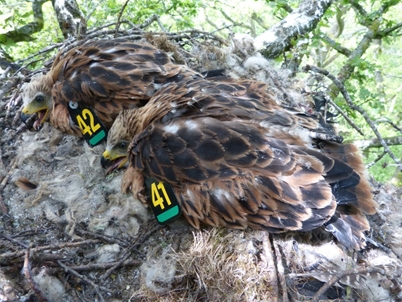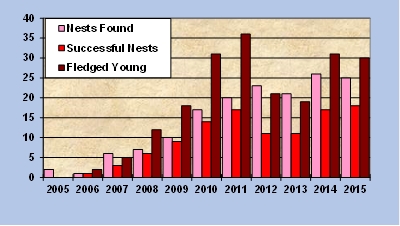The Welsh Kite Trust and the Shropshire Raptor Study Group again tried to find the nests of all breeding pairs of Red Kite in 2015. Three major milestones have now been passed:
- Over 200 fledged young since first successful breeding in 2006
- Over 150 fledged young tagged
- Over 20 tags read on individual nesting adults
Thirty one breeding pairs were found or reported, compared with 34 last year. Twenty-three nests were found, but access was refused to monitor two more (26 were found last year). Some of these nests are very close together: two are only around 400 metres apart, both were occupied last year, and this year both were successful. Another pair has neighbours at 2.1 and 1.3 kilometres, while a further pair has neighbours at 1.9 and 1.2 kilometres At least two other sets are less than thee kilometres apart.
 Nine of the found nests failed, but 18 were successful (one more than last year) and, assuming that all chicks large enough to tag survived, at least 31 young fledged from them. Nineteen of the fledged young from 10 nests were ringed and tagged. 2015 tags are green with black letters and black bottom strip on right wing, black with yellow letters and green bottom strip on left wing, as shown in the adjacent photo of two tagged chicks in a nest near Knighton.
Nine of the found nests failed, but 18 were successful (one more than last year) and, assuming that all chicks large enough to tag survived, at least 31 young fledged from them. Nineteen of the fledged young from 10 nests were ringed and tagged. 2015 tags are green with black letters and black bottom strip on right wing, black with yellow letters and green bottom strip on left wing, as shown in the adjacent photo of two tagged chicks in a nest near Knighton.
In common with previous years, the high turnover of nest sites continued. Twelve sites occupied by Kites last year had no nests in 2015, and 17 other sites, which have had breeding Kites in earlier years, were also checked, without result.
One nest was in a cleft of the main trunk in a very large Corsican pine. There were nine Heron nests in the same tree. The Herons may have provided early warning or protection from nearby potential predators. The nest was successful, fledging at least 1 young.
This is the second largest number of nests found in one year since Kites returned to breed here in 2005, after an absence of 130 years, but there were more fledged young (35) in 2011, from only 20 found nests. However productivity and nest numbers were the highest since 2011, with 2012 and 2013 badly affected by severe weather.
 Since the first nest was found in 2005, a total of 158 nests have been found, and 107 (68%) have been successful. Since the first successful breeding in 2006, at least 206 young are known to have flown from Shropshire nests, and 159 have been tagged. Average productivity has been 1.30 fledged young per nest found and 1.93 per successful nest. The number of nests found, successful nests and fledged young in each year is shown in the adjacent chart.
Since the first nest was found in 2005, a total of 158 nests have been found, and 107 (68%) have been successful. Since the first successful breeding in 2006, at least 206 young are known to have flown from Shropshire nests, and 159 have been tagged. Average productivity has been 1.30 fledged young per nest found and 1.93 per successful nest. The number of nests found, successful nests and fledged young in each year is shown in the adjacent chart.
No nests were in the northern half of the County (the SJ ordnance survey grid squares), but there were many reports of individual birds in the north, so breeding is expected here in the near future. The steady move eastwards was consolidated, with one of last year’s nests on Wenlock Edge re-occupied successfully, and another (not found) almost as far east as Brown Clee. Four young birds were also seen on Titterstone Clee, but the pair that probably nested there in 2013 did not return.
As the population increases and spreads, nests become harder to find, so the breeding population is now undoubtedly well over the 31 pairs located.
In 2014, an adult was found dead on the ground directly under one nest. There were no visible signs of injury or persecution, but the landowner had used rat poison in a nearby barn, so it is likely that this caused the death of the Kite. Two well grown chicks were later found dead in the nest, presumably from the same cause. The corpse of the adult was sent away for post-mortem analysis, but the results have not yet been received, 16 months later. Rat poison is a common cause of death, and it is found in potentially lethal amounts in most dead Kites sent for post-mortem.
Seven of the nesting adults in 2015 had wing tags, and six were read. A seven year old female was found near The Stiperstones, at a site where she previously nested in 2013 (but definitely not in 2014), less than two kilometres from her natal site. Of the other five, one was two years old, and three were three. The two year old male, paired with a three year old female, was unsuccessful. That female, and another of the three year old females, both newly found in 2015, came from the same nest near Aston-on-Clun. Another two sibling females, from a nest near Bishop’s Castle, were both found last year as well as in 2015. Unusually, the male had moved furthest (17km), while the four females had all moved less than 4km.
A total of 24 different tags have been read, 12 males, 10 females and two sex unknown. Males and females have both moved an average of 17 km from their natal site. However, three of these (two males and a female) were long-distance colonisers from Wales in 2007 and 2008. If these three are excluded, the averages are 8 km for males and 10 km for females. If subsequent colonisers from Wales are also excluded (i.e. only birds that moved within Shropshire are included) the averages are 5km for males but still 10 km for females. These figures illustrate yet again how sedentary Kites are, but there is a tendency for females to move further.
The average age of first breeding is 2.5 years, and average last observed breeding is 4 years. Three have reached 7 years old. The oldest was killed by a car, 8 years 7 months 7 days after ringing.
The original colonisers were native Welsh birds, and there is no evidence from wing tagging that birds from the various reintroduction programmes have nested here, though a 2005 bird from near Thrapston, in Northamptonshire, was seen at a roost in February 2010 and a month later near Bucknell, and others from the Chilterns have occasionally been recorded in Shropshire Bird Reports. However, recent DNA studies (Skujina, 2013). provide evidence that an adult breeding south of Clun in 2012 came from one of the reintroduced populations, possibly from Dumfries and Galloway, but originally from some of the birds introduced from Spain. The study needs to be extended before its origin can be identified with certainty (Mike Hayward, pers. comm.).
If anyone knows the location of a 2015 Kite nest, or finds one in 2016, please don’t assume we know about it. Please tell Leo Smith (01694 720296 or leo@leosmith.org.uk).
The Red Kite Experience at the Shropshire Hills Discovery Centre in Craven Arms started feeding last November, with the aim of attracting a limited number of Kites so people can see these wonderful birds at close quarters. However, it was not until May that any Kites started taking food, but only a few turned up sporadically, and they haven’t taken meat since early June, nor have they been seen with any regularity over the summer.
Hopefully some will start feeding over the coming winter. Once they are turning up regularly, visiting arrangements will be displayed here. As eight of the 25 nests found in 2015 are within 10 kilometres of the Centre, and there are probably others as well, the wait should not be very long.
Leo Smith
November 2015
Thanks to Michelle Frater, Dave Pearce and Vince Downs for helping find and monitor the nests, and to Tony Cross for ringing and tagging the chicks.
Reference
Skujina, I. 2013. Population genetics of an endangered bird of prey: the Red Kite in Wales. A thesis submitted in partial fulfilment of the degree of Master of Philosophy, Aberystwyth University, 2013.
Return to Red Kites in Shropshire
Return to Shropshire Raptor Study Group
